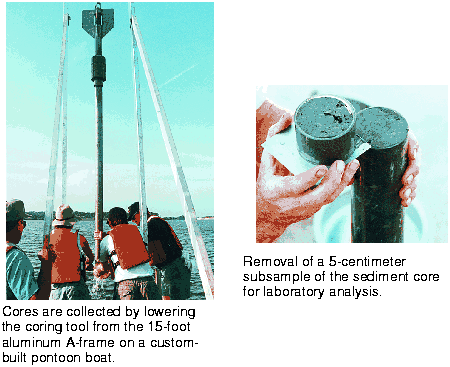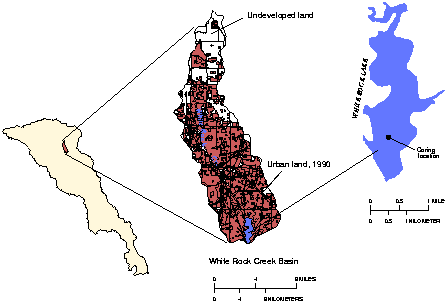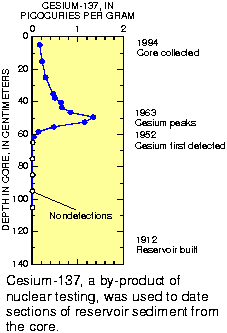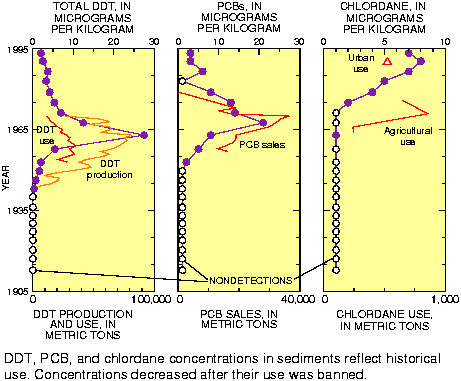


White Rock Lake was built in 1912 at a time when agriculture dominated land use. Since that time, the watershed has been incorporated into the growing Dallas metropolitan area. In 1935, urban land use in the watershed was 6 percent; by 1990, urban land use was 72 percent. The watershed is 100 square miles, and the surface area of the reservoir is 1.7 square miles. Sedimentation in the reservoir since its construction has reduced its storage capacity by one-half.

Sediment cores were collected near the dam from a pontoon boat. The reservoir sediment has a large water content relative to the pre-reservoir sediment, which was dry and crumbly. The cores, measured in centimeters (2.54 centimeters = 1 inch), were sliced into 2- to 5-centimeter sections that were analyzed for a number of constituents, including trace elements, organochlorine compounds, and polycyclic aromatic hydrocarbons (PAHs).

Age-dating of core sediments was done by analysis of their cesium-137 content. Cesium-137 is a by-product of nuclear weapons testing. It first occurred in the atmosphere in about 1952 and peaked during 1963--64. It adsorbs strongly to fine-grained sediments and therefore can be used to determine the time of deposition of sediments that have been exposed to atmospheric fallout. Cesium-137 first was detected in White Rock Lake core sediments at a depth of 60 to 63 centimeters (1952) and peaked at a depth of 48 to 51 centimeters (1963). The depth of the interface between pre-reservoir and reservoir sediment, 136 centimeters, corresponds to the reservoir construction date (1912), and the top of the core corresponds to the sampling date (July 1994).
Trends in DDT and PCBs in the White Rock Lake core coincide with historical use of these compounds. Use of the insecticide DDT peaked in the early 1960s before being banned by the EPA in 1972. Annual sales of PCBs, which have a variety of industrial uses, peaked in 1970. The EPA placed a voluntary ban on their use in 1973 and a complete ban in 1979. PCBs, DDT, and the DDT environmental degradation products DDE and DDD adsorb strongly to sediments and are resistant to further chemical breakdown (Van Metre and Callender, 1997).
chlordane use, and their subsequent bans, on water quality in White Rock Creek.
Unlike DDT and PCBs, chlordane was permitted for selected uses until the late 1980s. The primary uses in urban areas were the control of fire ants and termites. Chlordane concentrations in the White Rock Lake sediment core peaked about 1990
(Van Metre and Callender, 1997). Temporal trends in chlordane indicate relatively recent urban use of chlordane.
Concentrations of benzo(a)pyrene, lead, and zinc were relatively small and constant in sediments deposited before 1952 but began to increase in sediments deposited after that date.

Benzo(a)pyrene is a PAH and is in a class of carcinogenic compounds produced by the combustion of oil and gasoline. Elevated concentrations commonly are detected in urban areas. Benzo(a)pyrene is ranked eighth on the priority list of hazardous substances prepared by the Public Health Service in cooperation with EPA (Agency for Toxic Substances and Disease Registry, 1994). PAH and benzo(a)pyrene concentrations in sediments increased more than 20 times from pre-1950s to the early 1990s.

Lead concentrations in sediments deposited from 1952 to 1976 correspond to an increase in urbanization of the drainage basin and increased use of leaded gasoline. The marked decrease in lead concentrations in sediments deposited after 1976 coincides with the change from leaded to unleaded gasoline. Median lead concentrations have remained constant since the mid-1980s at double the pre-1952 concentrations, reflecting urban and industrial sources other than gasoline. The trend in lead concentrations thus reflects the effects of the change to unleaded gasoline and increased urbanization on water quality in White Rock Creek.
Zinc is used in tires and in a number of industrial processes and is present in concentrations 66 percent larger in recently deposited sediments than in those deposited before 1952.